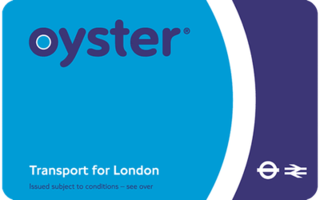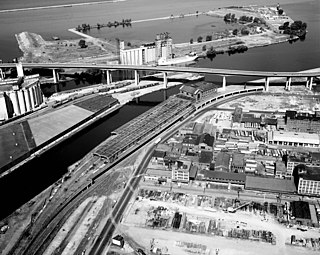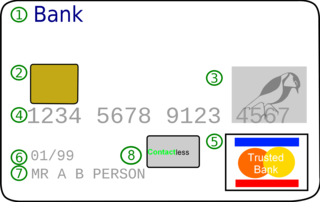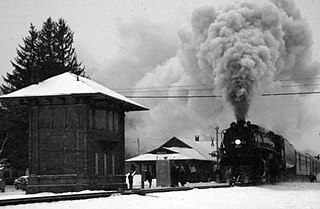
Metro-North Railroad, trading as MTA Metro-North Railroad, is a suburban commuter rail service run by the Metropolitan Transportation Authority (MTA), a public authority of the U.S. state of New York and under contract with the Connecticut Department of Transportation. Metro-North runs service between New York City and its northern suburbs in New York and Connecticut, including Port Jervis, Spring Valley, Poughkeepsie, Yonkers, New Rochelle, Mount Vernon, White Plains, Southeast and Wassaic in New York and Stamford, New Canaan, Danbury, Bridgeport, Waterbury, and New Haven in Connecticut. Metro-North also provides local rail service within the New York City boroughs of Manhattan and the Bronx. In 2021, the system had a ridership of 34,515,800, or about 191,200 per weekday as of the third quarter of 2022.

The New York Central Railroad was a railroad primarily operating in the Great Lakes and Mid-Atlantic regions of the United States. The railroad primarily connected greater New York and Boston in the east with Chicago and St. Louis in the Midwest, along with the intermediate cities of Albany, Buffalo, Cleveland, Cincinnati, Detroit, Rochester and Syracuse. New York Central was headquartered in New York City's New York Central Building, adjacent to its largest station, Grand Central Terminal.
The Pere Marquette Railway operated in the Great Lakes region of the United States and southern parts of Ontario in Canada. It had trackage in the states of Michigan, Ohio, Indiana and the Canadian province of Ontario. Its primary connections included Buffalo; Toledo; and Chicago. The company was named after Père Jacques Marquette S.J. (1637–1675), a French Jesuit missionary who founded Michigan's first European settlement, Sault Ste Marie.

The Oyster card is a payment method for public transport in London in England, United Kingdom. A standard Oyster card is a blue credit-card-sized stored-value contactless smart card. It is promoted by Transport for London (TfL) and can be used on travel modes across London including London Buses, London Underground, the Docklands Light Railway (DLR), London Overground, Tramlink, some river boat services, and most National Rail services within the London fare zones. Since its introduction in June 2003, more than 86 million cards have been used.

The Erie Lackawanna Railway, known as the Erie Lackawanna Railroad until 1968, was formed from the 1960 merger of the Erie Railroad and the Delaware, Lackawanna & Western Railroad. The official motto of the line was "The Friendly Service Route".
The Lake Shore and Michigan Southern Railway, established in 1833 and sometimes referred to as the Lake Shore, was a major part of the New York Central Railroad's Water Level Route from Buffalo, New York, to Chicago, Illinois, primarily along the south shore of Lake Erie and across northern Indiana. The line's trackage remains a major rail transportation corridor used by Amtrak passenger trains and several freight lines; in 1998, its ownership was split at Cleveland between CSX Transportation to the east and Norfolk Southern Railway in the west.

The Gulf, Mobile and Ohio was a Class I railroad in the central United States whose primary routes extended from Mobile, Alabama, and New Orleans, Louisiana, to St. Louis and Kansas City, Missouri, as well as Chicago, Illinois.

An airport lounge is a facility operated at many airports. Airport lounges offer, for selected passengers, comforts beyond those afforded in the airport terminal itself, such as more comfortable seating, quieter environments, and often better access to customer service representatives. Other accommodations may include private meeting rooms, telephones, wireless internet access and other business services, along with provisions to enhance passenger comfort, such as free drinks, snacks, magazines, and showers.

The Metro Rail Maintenance Yard or "South Park Terminal" houses Buffalo Metro Rail's cars in a train shed at the former Delaware, Lackawanna and Western Railroad terminal in the Cobblestone District of Buffalo, New York. The property is located at the southernmost fringe of the Central Business District. The station was built in 1917, and was designed to handle both steam trains and steamships. The storage and maintenance facility was converted to its present condition in 1982, following the demolition of the former main terminal concourse building "headhouse" of the DL&W Terminal in 1979.

The Cincinnatian was a named passenger train operated by the Baltimore and Ohio Railroad (B&O). The B&O inaugurated service on January 19, 1947, with service between Baltimore, Maryland and Cincinnati, Ohio, carrying the number 75 westbound and 76 eastbound, essentially a truncated route of the National Limited which operated between Jersey City, New Jersey and St. Louis.

The Breeze Card is a stored value smart card that passengers use as part of an automated fare collection system which the Metropolitan Atlanta Rapid Transit Authority (MARTA) introduced to the general public in early October 2006. The card automatically debits the cost of the passenger’s ride when placed on or near the Breeze Target at the fare gate. Transit riders are able to add value or time-based passes to the card at Breeze Vending Machines (BVM) located at all MARTA stations. The major phases of MARTA's Breeze transformation took place before July 1, 2007 when customers were still able to purchase TransCards from ridestores or their employers. They were also able to obtain paper transfers from bus drivers to access the train. As of July 1, 2007 the TransCard and the paper transfers were discontinued and patrons now use a Breeze Card or ticket to access the system, and all transfers are loaded on the card. Breeze Vending Machines (BVM) distribute regional transit provider passes The Breeze Card employs passive RFID technology currently in use in many transit systems around the world.

Avantix Mobile ("AVB") is a portable railway ticket issuing system used across the British railway network from 2001 to 2017.
Seoul, the capital and largest city in South Korea, accounts for only 0.6% of the country's total land area, yet it is home to around 19% of the population. The population density in Seoul demands a great deal of the city's transportation systems, which are regarded by many as among the best and most advanced in the world. Seoul is very well connected by its subway and bus systems, and the city is also very supportive of pedestrian foot travel. In 2006 it won the Sustainable Transport Award.

The OV-chipkaart is a contactless smart card system used for all public transport in the Netherlands. First introduced in the Rotterdam Metro in April 2005, it has subsequently been rolled out to other areas and travel modes. It fully replaced the national strippenkaart system for buses, trams, and metro trains in 2011, and the paper ticket system for rail travel in July 2014.

A transit pass or travel card, often referred to as a bus pass or train pass etc., is a ticket that allows a passenger of the service to take either a certain number of pre-purchased trips or unlimited trips within a fixed period of time.

A credit card is a payment card issued to users (cardholders) to enable the cardholder to pay a merchant for goods and services based on the cardholder's accrued debt. The card issuer creates a revolving account and grants a line of credit to the cardholder, from which the cardholder can borrow money for payment to a merchant or as a cash advance. There are two credit card groups: consumer credit cards and business credit cards. Most cards are plastic, but some are metal cards, and a few gemstone-encrusted metal cards.

Tobyhanna is a proposed NJ Transit commuter rail station located in Coolbaugh Township, Monroe County, Pennsylvania. The station forms part of a site owned by a number of public and private entities including the Pennsylvania Northeast Regional Railroad Authority. The site is adjacent to the former Delaware, Lackawanna and Western Railroad station; the building remains in place and is in use as the local historical society rail museum. In spring 2021, Amtrak announced plans for potential New York-Scranton route.

Opal is a contactless fare collection system for public transport services in the greater Sydney area and most other urban areas of New South Wales, Australia. Operation of the Opal system is managed by the New South Wales Government's transport authority, Transport for NSW. First launched in late 2012, Opal is valid on Transport for NSW's metro, train, bus, ferry and light rail services that operate in Sydney and the neighbouring Central Coast, Hunter Region, Blue Mountains, Illawarra and Southern Highlands areas. Opal equipment was designed from the start to support a variety of cards, but launched with the captive Opal cards.
GO Transit is the inter-regional transportation authority of the Golden Horseshoe, which includes the Greater Toronto and Hamilton Area. It is Canada's oldest regional transit system, first serving passengers in 1967.

The TFI Leap Card is a contactless smart card for automated fare collection overseen by Transport for Ireland (TFI). It was introduced in the Greater Dublin area in 2011 for Luas, DART, Iarnród Éireann and Dublin Bus, but acceptance has significantly expanded, and it is now accepted in cities nationwide and on some longer distance commuter routes. Initially, Leap Cards offered only a pre-paid electronic wallet system for single-trip fares; since May 2014, it has also been possible to load it with weekly, monthly and annual subscriptions. In September 2017, there were over 2.5 million Leap Card users according to the National Transport Authority. The Leap Card is the result of many years' work by the Railway Procurement Agency and the National Transport Authority as part of the rollout of an integrated ticketing scheme for public transport in Dublin city. Fares are generally discounted compared to cash prices, and integrated ticketing is offered in the Dublin area via a flat fare system across all modes of transport. The minimum top-up for the card is currently €5, and it can be topped up via iPhone/Android App, at LUAS or DART ticketing machines, and in convenience stores offering Payzone services.
"Saved by the Rail Travel Card". J. David Ingles. Classic Trains Fall 2012 pp. 35–37
















